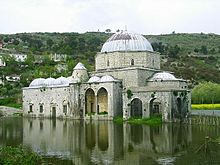Lead Mosque (Shkodra)
The lead mosque ( Albanian Xhamia e Plumbit ) is an important historical building in the northwest Albanian Shkodra . It is considered to be the largest historical mosque in the country. The lead mosque is located in an area that is often flooded.
The mosque owes its name to the lead domes.
history
Time of origin
The building was built in 1773 by the Albanian Pasha Mehmed Bushati , a famous member of the noble Bushati family , who was vizier of the Paschalik Shkodra at that time . He hoped that his place of birth would have the character of a capital. According to a legend, Mehmed Bushati is said to have walked from the Rozafa fortress to the mosque every day to watch the construction progress.
The mosque was renovated several times during its history, for example in 1863, 1920 and 1963. After the great flood of 1865, it was devastated for a long time.
Damage
During the 1900s the mosque was badly damaged several times, including when the lead from the dome was stolen. In 1916 the missing building material was replaced by Austro-Hungarian troops.
In 1967 the minaret , which had previously been renovated in 1920 by Xhelal Bushati , a descendant of Mehmed, was badly damaged by a lightning strike or the revolutionary mob. It has not been rebuilt to this day, only the base has been preserved.
Closure of the mosque
In 1967 the mosque, like other religious institutions in the country, was closed after the communist leader Enver Hoxha declared Albania the first atheist state on earth. From then on, any practice of religion was forbidden. Although many mosques were destroyed by the regime during this time, the building was the only one of Shkodra's 35 mosques to survive, probably because of a declaration on the protection of cultural monuments from 1948.
Post communism and reopening
The mosque was reopened on November 16, 1990 when the religious ban was lifted. The first Islamic worship service in the country took place in this mosque when the Hodscha Hafiz Sabri Koçi led the prayer publicly for the community again after 23 years.
On April 2, 1991, during unrest after the first free elections, believers were shot at by paramilitaries in the mosque .
The Institute for Cultural Monuments in Tirana announced in 2011 that it would restore the building within a few months with Kuwaiti help and renew the area surrounding the mosque. Certain work was also carried out. The interior of the mosque was painted, but the minaret was not rebuilt. In 2013 the mosque was again under water after heavy rainfall.
Construction
The building has an Ottoman architecture and is similar to the classical 16th century, which was significantly influenced by the architect Mimar Sinan . It is a single-dome mosque that is extended by an apse in which the mihrab is located. On each side there is a portico covered by two or three domes .
In front of the prayer room is a courtyard that measures around 12.5 by 13.8 meters and is surrounded on all sides by a walkway that is covered by small domes. Such an elaborately designed forecourt is unique in Albania.
The building blocks of the mosque are all the same size, which is particularly characteristic of the symmetrical construction. Only the base of the minaret, which had a roof with a pencil tip, is left, the stairs of which are roofed with lead today.
Web links
- Shkoder.net: Xhamia e Plumbit . (Albanian)
Individual evidence
- ^ A b c d Machiel Kiel : Ottoman architecture in Albania (1385–1912) . In: Research Center for Islamic History, Art and Culture (Ed.): Islamic art series . tape 5 . Istanbul 1990, ISBN 92-9063-330-1 , pp. 231-233 .
- ↑ a b c d e f Mirsad Sylja: Si po shkatërrohet “Xhamia e Plumbit”, pasuria mbi 100-vjeçare. In: Peshku pa ujë. August 20, 2008, accessed April 2, 2018 (Albanian).
- ↑ a b c d Anila Dushi: Xhamia e plumbit po kalbet. (No longer available online.) July 22, 2008, archived from the original on January 27, 2010 ; Retrieved January 30, 2010 (Albanian). Info: The archive link was inserted automatically and has not yet been checked. Please check the original and archive link according to the instructions and then remove this notice.
- ↑ a b Katolikët restaurojnë xhaminë e plumbit (The Catholics restore the lead mosque). In: Pajtimi.com. Retrieved January 30, 2010 (Albanian).
- ↑ a b Xhamia e Plumbit. (No longer available online.) September 1999, archived from the original on January 25, 2016 ; Retrieved January 25, 2016 (Albanian).
- ^ A b Miranda Vickers, James Pettifer: Albania - From Anarchy to a Balkan Identity . New York University Press, New York 1997, ISBN 0-8147-8794-0 .
- ↑ Shkodër, Xhamia e Plumbit në pritje të restaurimit (Shkodra, the lead moshe awaiting restoration). In: Top Channel . April 25, 2011, Retrieved November 9, 2013 (Albanian).
- ↑ Meike Gutzweiler: Reise Know-How Albania . Peter Rump, Bielefeld 2012, ISBN 978-3-8317-2194-8 .
- ↑ Shkodër, 4000 ha tokë dhe Xhamia e Plumbit nën ujë. In: Shekulli . March 21, 2013, accessed April 2, 2018 (Albanian).
- ↑ TV report about floods at the lead mosque on YouTube (March 21, 2013, Albanian)
- ↑ Guntram Koch (ed.): Albania - cultural monuments of an unknown country from 2200 years . Photo exhibition of the seminar for Christian archeology and Byzantine art history at the Philipps University of Marburg. Marburg 1985.
Coordinates: 42 ° 2 ′ 47.5 ″ N , 19 ° 29 ′ 57.9 ″ E







